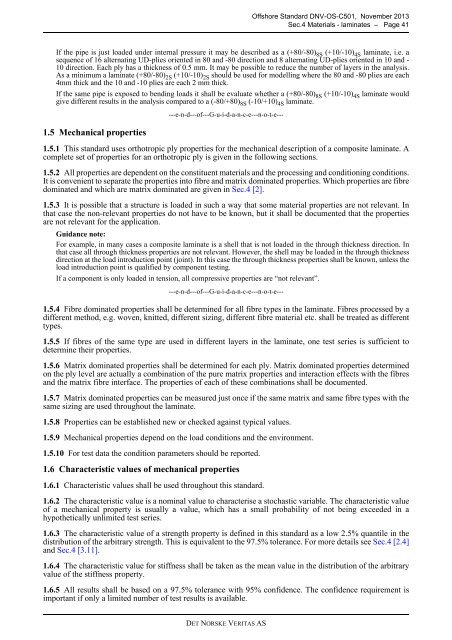OS-C501
Create successful ePaper yourself
Turn your PDF publications into a flip-book with our unique Google optimized e-Paper software.
Offshore Standard DNV-<strong>OS</strong>-<strong>C501</strong>, November 2013<br />
Sec.4 Materials - laminates – Page 41<br />
If the pipe is just loaded under internal pressure it may be described as a (+80/-80) 8S (+10/-10) 4S laminate, i.e. a<br />
sequence of 16 alternating UD-plies oriented in 80 and -80 direction and 8 alternating UD-plies oriented in 10 and -<br />
10 direction. Each ply has a thickness of 0.5 mm. It may be possible to reduce the number of layers in the analysis.<br />
As a minimum a laminate (+80/-80) 2S (+10/-10) 2S should be used for modelling where the 80 and -80 plies are each<br />
4mm thick and the 10 and -10 plies are each 2 mm thick.<br />
If the same pipe is exposed to bending loads it shall be evaluate whether a (+80/-80) 8S (+10/-10) 4S laminate would<br />
give different results in the analysis compared to a (-80/+80) 8S (-10/+10) 4S laminate.<br />
1.5 Mechanical properties<br />
---e-n-d---of---G-u-i-d-a-n-c-e---n-o-t-e---<br />
1.5.1 This standard uses orthotropic ply properties for the mechanical description of a composite laminate. A<br />
complete set of properties for an orthotropic ply is given in the following sections.<br />
1.5.2 All properties are dependent on the constituent materials and the processing and conditioning conditions.<br />
It is convenient to separate the properties into fibre and matrix dominated properties. Which properties are fibre<br />
dominated and which are matrix dominated are given in Sec.4 [2].<br />
1.5.3 It is possible that a structure is loaded in such a way that some material properties are not relevant. In<br />
that case the non-relevant properties do not have to be known, but it shall be documented that the properties<br />
are not relevant for the application.<br />
Guidance note:<br />
For example, in many cases a composite laminate is a shell that is not loaded in the through thickness direction. In<br />
that case all through thickness properties are not relevant. However, the shell may be loaded in the through thickness<br />
direction at the load introduction point (joint). In this case the through thickness properties shall be known, unless the<br />
load introduction point is qualified by component testing.<br />
If a component is only loaded in tension, all compressive properties are “not relevant”.<br />
---e-n-d---of---G-u-i-d-a-n-c-e---n-o-t-e---<br />
1.5.4 Fibre dominated properties shall be determined for all fibre types in the laminate. Fibres processed by a<br />
different method, e.g. woven, knitted, different sizing, different fibre material etc. shall be treated as different<br />
types.<br />
1.5.5 If fibres of the same type are used in different layers in the laminate, one test series is sufficient to<br />
determine their properties.<br />
1.5.6 Matrix dominated properties shall be determined for each ply. Matrix dominated properties determined<br />
on the ply level are actually a combination of the pure matrix properties and interaction effects with the fibres<br />
and the matrix fibre interface. The properties of each of these combinations shall be documented.<br />
1.5.7 Matrix dominated properties can be measured just once if the same matrix and same fibre types with the<br />
same sizing are used throughout the laminate.<br />
1.5.8 Properties can be established new or checked against typical values.<br />
1.5.9 Mechanical properties depend on the load conditions and the environment.<br />
1.5.10 For test data the condition parameters should be reported.<br />
1.6 Characteristic values of mechanical properties<br />
1.6.1 Characteristic values shall be used throughout this standard.<br />
1.6.2 The characteristic value is a nominal value to characterise a stochastic variable. The characteristic value<br />
of a mechanical property is usually a value, which has a small probability of not being exceeded in a<br />
hypothetically unlimited test series.<br />
1.6.3 The characteristic value of a strength property is defined in this standard as a low 2.5% quantile in the<br />
distribution of the arbitrary strength. This is equivalent to the 97.5% tolerance. For more details see Sec.4 [2.4]<br />
and Sec.4 [3.11].<br />
1.6.4 The characteristic value for stiffness shall be taken as the mean value in the distribution of the arbitrary<br />
value of the stiffness property.<br />
1.6.5 All results shall be based on a 97.5% tolerance with 95% confidence. The confidence requirement is<br />
important if only a limited number of test results is available.<br />
DET NORSKE VERITAS AS



